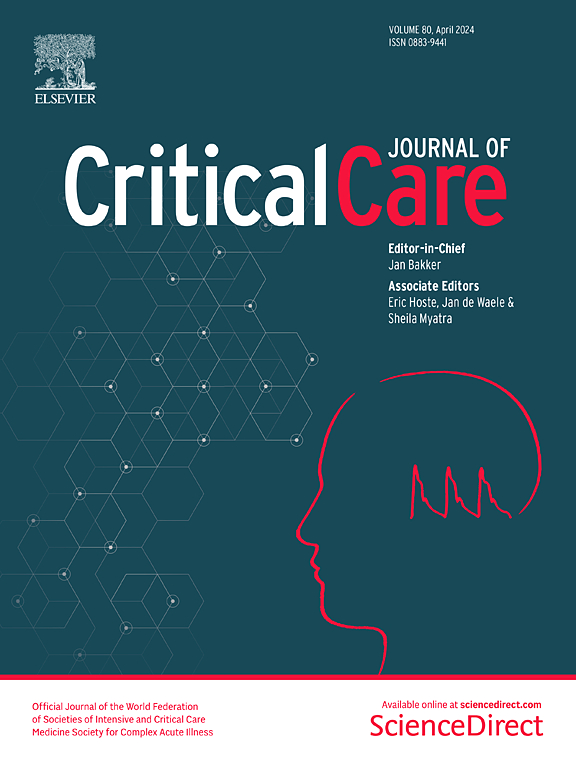血浆H3.1核小体作为感染、炎症和器官衰竭的生物标志物
IF 8.8
1区 医学
Q1 CRITICAL CARE MEDICINE
引用次数: 0
摘要
中性粒细胞胞外陷阱(NET)是先天免疫反应的重要组成部分,而过多的NET形成会导致组织损伤。H3.1核小体是NETs的一个组成部分,已成为一种潜在的生物标志物。本研究旨在评估危重疾病中的H3.1核小体,评估它们与败血症、器官衰竭、炎症亚表型和预后的关系。使用MARS队列,包括连续的重症监护病房患者,在第0、2和4天收集血浆样本。用Nu法测定H3.1核小体浓度。Q®NETs免疫分析法在基线和纵向上比较败血症和器官衰竭患者的H3.1核小体浓度。探讨H3.1核小体浓度与临床预后的关系。纳入重症患者1713例,共采集血浆样本3671份。基线H3.1核小体浓度在临床确诊的败血症(740 ng/mL)、未确诊的败血症(416 ng/mL)和非败血症(463 ng/mL, P < 0.001)之间存在差异。H3.1浓度与SOFA评分相关(r = 0.40),弥散性血管内凝血、急性肾损伤和高炎性脓毒症患者H3.1浓度较高。H3.1浓度高度预测肾脏替代治疗的需要(每增加log10的风险比为2.00),校正了死亡率。脓毒症和器官衰竭与血浆H3.1核小体浓度密切相关。虽然败血症和器官衰竭的个体诊断表现仍然很低,但H3.1水平预测了肾脏替代治疗和弥散性血管内凝血的需要,揭示了对先天免疫反应的独特见解。试验注册:ClinicalTrials.gov识别码NCT01905033;IRB编号10-056C,登记于2010年6月16日。本文章由计算机程序翻译,如有差异,请以英文原文为准。
Plasma H3.1 nucleosomes as biomarkers of infection, inflammation and organ failure
Neutrophil extracellular traps (NETs) are a vital part of the innate immune response, while excessive NET formation can cause tissue damage. H3.1 nucleosomes, a component of NETs, have emerged as a potential biomarker. This study aimed to evaluate H3.1 nucleosomes in critical illness, assessing their relationship with sepsis, organ failure, inflammatory subphenotypes and outcomes. The MARS cohort was used, comprising of consecutive Intensive Care Unit patients, with plasma samples collected on days 0, 2 and 4. H3.1 nucleosome concentrations were measured using the Nu.Q® NETs Immunoassay. H3.1 nucleosome concentrations were compared across sepsis presence and organ failure, both at baseline and longitudinally. The relationship between H3.1 nucleosome concentrations and clinical outcomes was investigated. 1713 critically ill patients were included, with a total of 3671 plasma samples. Baseline H3.1 nucleosome concentrations differed between sepsis confirmed by clinical adjudication (740 ng/mL), sepsis unconfirmed by clinical adjudication (416 ng/mL) and non-sepsis (463 ng/mL, P < 0.001). H3.1 concentrations were associated with SOFA score (r = 0.40) and were higher in patients with disseminated intravascular coagulation, acute kidney injury and hyperinflammatory sepsis. H3.1 concentration was highly predictive for the need of renal replacement therapy (hazard ratio 2.00 per log10 increase), correcting for mortality. Sepsis and organ failure were closely associated with plasma H3.1 nucleosome concentrations. While individual diagnostic performance for sepsis and organ failure remained low, H3.1 levels predicted the need for renal replacement therapy and disseminated intravascular coagulation, revealing unique insights into the innate immune response. Trial registration: ClinicalTrials.gov identifier NCT01905033; IRB number 10-056C, registered June 16, 2010.
求助全文
通过发布文献求助,成功后即可免费获取论文全文。
去求助
来源期刊

Critical Care
医学-危重病医学
CiteScore
20.60
自引率
3.30%
发文量
348
审稿时长
1.5 months
期刊介绍:
Critical Care is an esteemed international medical journal that undergoes a rigorous peer-review process to maintain its high quality standards. Its primary objective is to enhance the healthcare services offered to critically ill patients. To achieve this, the journal focuses on gathering, exchanging, disseminating, and endorsing evidence-based information that is highly relevant to intensivists. By doing so, Critical Care seeks to provide a thorough and inclusive examination of the intensive care field.
 求助内容:
求助内容: 应助结果提醒方式:
应助结果提醒方式:


